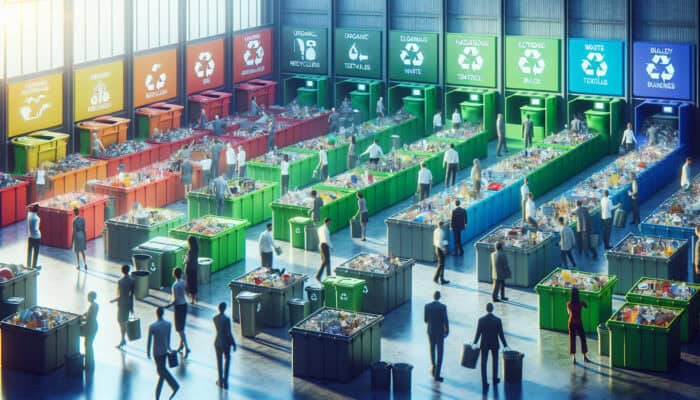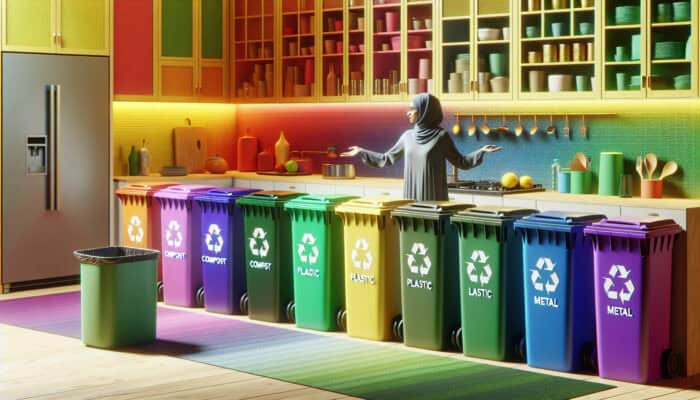Ultimate Resource for Effective Waste Sorting in Clearances
Defining Waste Sorting and Its Critical Importance

Best Bins for Waste Sorting in Clearances: Waste sorting refers to the systematic approach of classifying different types of waste materials with the aim of enhancing recycling efforts and ensuring responsible disposal practices. This vital process significantly contributes to environmental sustainability, making it essential for everyone to be familiar with the various waste categories to effectively sort their waste. The most recognized categories include:
- Recyclables (like plastic, paper, and glass)
- General waste (which encompasses non-recyclable materials)
- organic waste (including food scraps and garden refuse)
- Hazardous materials (such as batteries and chemicals)
- E-waste (pertaining to electronic devices)
- Construction debris
- Textiles (including clothing and fabric)
- Bulk waste (which includes large items like furniture)
By engaging in proper waste sorting, we not only enhance the efficiency of the disposal process but also maximize the potential for recycling, which, in turn, reduces landfill dependence and lessens the environmental impact associated with waste disposal.
Recognizing the Role of Clearances in Waste Management
Clearances play a fundamental role in waste management by establishing specific areas for sorting and disposal, which is crucial in maintaining community cleanliness and organization. The benefits of implementing clearances in waste management strategies include:
- Enhanced organization of diverse waste types
- Reduction of contamination within recyclable waste
- Improved community health and hygiene standards
- Streamlined waste collection processes
- Increased awareness and participation in recycling initiatives
- Support for local environmental policies
- Promotion of responsible waste disposal habits
- Provision of a visually appealing public environment
By adopting effective clearance strategies, communities can cultivate a culture of sustainability and shared responsibility concerning waste management, resulting in a cleaner and greener living environment.
Investigating Various Types of Bins Used in Clearances
A wide array of bins is specifically engineered for different waste categories, each serving a unique function in the efficient management of waste. These bins are integral to successful sorting and include: recycling bins, general waste bins, organic waste bins, and hazardous waste containers. Recycling bins, often identified by blue or green colors, are designated for materials that can be recycled, such as paper, cardboard, and certain plastics. General waste bins, typically black, are reserved for items that are not recyclable. Organic waste bins, which may be brown or green, are intended for compostable materials, while hazardous waste containers are clearly labeled to indicate their contents, ensuring safe disposal practices. Understanding the specific roles of each bin type is essential for effective waste sorting, ultimately leading to improved recycling rates and a decrease in landfill waste.
Expert Insights on Selecting the Best Bins for Waste Sorting in Clearances

Key Recommendations from Experts for Selecting the Right Bins
When selecting bins for waste sorting during clearances, experts recommend considering several crucial factors to ensure optimal functionality. These factors include the size of the bin, the material it is constructed from, and its sorting capabilities. Choosing the appropriate size is vital to accommodate the expected volume of waste without overflow, which can lead to contamination and hygiene issues. The material choice affects the bin’s durability and longevity; for example, plastic bins are lightweight and resistant to rust, while metal bins offer greater durability but may require more maintenance. Sorting capabilities, such as the number of compartments, facilitate efficient segregation of various waste types, prompting users to engage in responsible disposal practices.
Real-world examples from various locations in the UK illustrate the effectiveness of carefully selected bins. For example, a local council in Manchester introduced dual-compartment bins in public parks to enhance source sorting, resulting in an impressive increase in recycling rates of up to 40%. This successful initiative demonstrates how tailored bin selections can significantly influence community participation in waste sorting efforts.
Identifying Essential Features for High-Quality Bins
High-quality bins must incorporate several indispensable features to ensure they are both effective and user-friendly. Durability is paramount; bins should be designed to endure various weather conditions and potential vandalism. Furthermore, bins need to be weather-resistant, especially given the unpredictable UK climate, to prevent deterioration over time. Clear labeling is also essential; bins should have prominent, easy-to-understand labels that guide users in accurately sorting their waste.
To evaluate bin quality before purchasing, actionable steps can be taken, such as inspecting the material for sturdiness, looking for user-friendly features like foot pedals or lids, and ensuring that the bin is easy to clean. Additionally, opting for bins with color-coded compartments can simplify the sorting process, allowing users to quickly determine where to dispose of their waste. Investing in high-quality bins not only guarantees a longer lifespan but also facilitates a more efficient waste management process.
Strategic Placement of Bins to Enhance Waste Sorting Efficiency

The strategic placement of bins is crucial for improving sorting efficiency and promoting user compliance. Expert guidance suggests that bins should be situated in high-traffic areas where they are both visible and accessible. Positioning bins in close proximity to one another can also encourage users to engage in proper sorting practices.
Another effective strategy involves using educational signage alongside bins, illustrating what can and cannot be disposed of in each bin. For instance, placing recycling bins near the entrances of buildings can lead to higher sorting rates, as individuals are more likely to participate in the process when the bins are readily available. Additionally, adapting bin placements based on specific events or seasonal changes can further optimize waste sorting; thus, it’s essential to regularly analyze usage patterns to inform future placements.
Leveraging Technology to Transform Waste Sorting in Bins
Technology is playing a transformative role in enhancing the efficiency of waste sorting in bins. Innovations such as smart bins equipped with sensors can notify waste management services when they are full, ensuring timely collection and maintenance. Some bins even feature smart labels that guide users on proper sorting through QR codes or digital displays. This technology can provide real-time data on waste levels and types, facilitating more effective inventory management and planning.
In the UK, smart bins have been deployed in major urban areas, demonstrating notable improvements in waste segregation and overall management. For instance, a pilot project in London introduced smart recycling bins that communicate with local authorities, ensuring collections are conducted just in time, significantly reducing overflow and contamination rates. By harnessing technological advancements, municipalities can greatly enhance their waste management practices, leading to more effective sorting and disposal solutions.
Top Bin Models for Efficient Waste Sorting
Popular Bin Models Available in the Market
In the UK, numerous bin models have gained recognition for their durability, design, and effectiveness in facilitating waste sorting. Renowned brands such as Simplehuman and Brabantia lead the market by offering a diverse selection of bins tailored for various waste categories. For instance, Simplehuman’s recycling bin boasts dual compartments with a sturdy design, making it ideal for both residential and office settings. Brabantia’s signature Touch Bin is another favored option, esteemed for its sleek appearance and efficient waste sorting features.
Key characteristics found in leading bin models include:
- Dual-compartment designs for straightforward sorting
- Foot-pedal operation for hands-free use
- Durable, corrosion-resistant materials
- Clear labeling and color-coded sections
- Odour-proof lids for hygienic disposal
- Easy-to-clean designs with detachable inner buckets
- Constructed from recycled materials for eco-friendliness
- Customizable sizes to fit a variety of spaces
These models not only facilitate effective waste segregation but also seamlessly integrate into contemporary homes and workplaces, promoting responsible disposal practices.
Comparing Performance of Different Bin Materials
Bins can be constructed from various materials, including plastic, metal, and wood, each offering unique advantages concerning durability, cost, and environmental impact. Plastic bins are lightweight and rust-resistant, making them suitable for outdoor environments; however, they may not always match the strength of metal alternatives. Metal bins, often made from stainless steel, offer superior durability and longevity, though they can be more expensive and require regular maintenance to prevent corrosion.
Wooden bins, while visually appealing and suitable for specific settings, may not provide the same level of weather resistance as plastic or metal options. Additionally, they can be more challenging to clean and maintain. Ultimately, the choice of material should reflect not only the intended use of the bin but also the community’s commitment to environmental considerations, thereby supporting sustainable waste management practices.
Where to Buy Bins for Waste Clearances
Specialized bins for waste sorting can be acquired from a variety of outlets throughout the UK, ranging from local hardware stores to specialized waste management suppliers. Online platforms such as Amazon and eBay also present a wide selection of bin models and materials, often featuring customer reviews to aid in purchasing decisions. Moreover, many local councils provide details on approved suppliers that comply with local waste management standards, ensuring that bins obtained contribute to effective waste sorting endeavors.
Specialized waste management suppliers frequently offer customization options, allowing customers to choose features that align with their specific needs, such as color coding or additional compartments. It’s advisable to compare prices and features from various sources to make an informed decision that balances budget and functionality.
Key Benefits of Utilizing Bins for Waste Sorting in Clearances
Impact of Waste Sorting on Environmental Health
Effective waste sorting significantly enhances environmental health by reducing landfill waste and increasing recycling rates. When waste materials are appropriately sorted, recyclable items are diverted from landfills, thereby lessening the overall waste volume. This process not only conserves natural resources but also decreases greenhouse gas emissions associated with waste decomposition in landfills.
The environmental benefits of proper waste sorting include:
- Reduced landfill size and related methane emissions
- Conservation of natural resources through recycling initiatives
- Decreased energy usage in the production of recycled products
- Improved air and water quality through minimized hazardous waste
- Promotion of biodiversity by limiting habitat destruction due to mining and raw material extraction
- Encouragement of sustainable community practices and heightened awareness
- Reduction of the overall environmental footprint of waste management systems
- Support for local recycling efforts
By prioritizing effective waste sorting, communities can make significant strides toward achieving environmental sustainability and nurturing a healthier planet.
Economic Advantages of Waste Sorting
Waste sorting offers substantial economic benefits, particularly in terms of cost savings and potential revenue generation. By reducing the quantity of waste sent to landfills, facilities can lower disposal fees, which can be quite high in urban areas. Enhanced sorting can also lead to increased volumes of recyclable materials collected, creating opportunities for revenue through the sale of these materials to recycling facilities.
Moreover, efficient waste sorting systems can reduce operational costs for waste management firms, as more materials are processed for recycling instead of being disposed of. These savings can ultimately be reinvested into community programs or infrastructure enhancements, further strengthening local economic stability. Through strategic waste sorting initiatives, communities can realize economic advantages while simultaneously promoting sustainable practices.
Enhancing Community Well-Being Through Waste Sorting
Proper waste sorting during clearances cultivates community pride and responsibility, resulting in cleaner and more attractive living environments. When community members actively engage in effective waste sorting, they develop a sense of ownership over their surroundings, which can strengthen communal bonds and enhance the overall quality of life. Well-maintained clearances not only reflect positively on neighborhoods but can also draw visitors and potentially benefit local businesses.
Additionally, clean environments are linked to improved mental health and well-being, fostering a sense of safety and security among residents. By promoting waste sorting initiatives, communities can nurture a culture of sustainability and social responsibility, leading to a cleaner environment and a stronger sense of community cohesion and belonging.
Research-Driven Insights on Optimal Bins for Waste Sorting in Clearances
What Research Indicates About Bin Efficiency?
Research indicates that well-designed bins significantly improve recycling rates and reduce contamination levels. Studies reveal that clear and intuitive designs, including color coding and appropriate labeling, enhance user compliance, leading to better sorting outcomes. Well-structured waste management systems equipped with thoughtfully designed bins can boost recycling rates by as much as 60%, underscoring the profound impact that bin design has on sorting efficiency.
Expert analyses confirm that the arrangement and features of bins directly influence user behavior, promoting proper waste disposal practices. Therefore, investing in high-quality, thoughtfully designed bins is essential for effective waste management strategies in clearances.
Influence of Bin Design on User Behavior
Bin design is crucial in determining how users sort their waste, encouraging higher compliance with sorting practices. Elements such as color coding and clear labeling can significantly shape user behavior, as individuals are more likely to participate when the sorting process is straightforward and intuitive. Visually appealing and user-friendly bins can motivate participation, creating a positive experience for users.
Furthermore, research has shown that bins equipped with visual prompts or instructional signage can enhance sorting practices, as users receive clear guidance on how to dispose of their waste correctly. By refining the design and functionality of bins, communities can foster a culture of responsible waste disposal, leading to improved recycling rates and reduced contamination levels.
Long-Term Benefits of Investing in Quality Bins
Quality bins provide immediate advantages in terms of durability and functionality while encouraging consistent waste sorting habits over the long term. When communities invest in high-quality bins, they are more likely to adopt sustainable waste management practices, resulting in lasting environmental and economic benefits. Durable bins withstand time, minimizing the need for frequent replacements and subsequent waste generation.
Additionally, quality bins foster a sense of accountability among users, as individuals are more inclined to respect and utilize well-maintained, efficient systems. This adherence to proper waste sorting practices can create a positive feedback loop, reinforcing responsible behaviors and leading to sustained improvements in recycling rates and community engagement over time.
Enhancing Waste Sorting Practices Through Optimal Bin Placement
Strategic bin placement is essential for improving accessibility and visibility, which directly affects user engagement and effective waste sorting practices. Bins should be strategically positioned in high foot-traffic areas, ensuring they are conveniently located for users to facilitate proper waste disposal. Placing bins near communal areas, parks, or event spaces can significantly increase sorting efficiency, as they are readily available when individuals are most likely to generate waste.
Regular analysis of bin usage patterns can inform placement strategies, enabling communities to adapt based on user behavior. Additionally, incorporating educational signage alongside bins can further engage users and promote responsible waste disposal. By prioritizing optimal bin placement, communities can establish effective waste management systems that encourage sorting compliance and enhance overall waste management efforts.
Corporate Sustainability Goals and the Role of Efficient Waste Bins
Bins designed for efficient waste sorting are critical in achieving corporate sustainability objectives, significantly contributing to waste reduction and recycling initiatives. By providing accessible and clearly labeled waste disposal options, businesses can encourage employees and customers to engage in sustainable practices. Implementing a robust waste sorting system demonstrates a commitment to environmental stewardship and can enhance a company’s public image.
Moreover, effective waste management can lead to considerable cost savings for businesses, reinforcing the economic rationale for investing in quality sorting bins. Aligning waste sorting initiatives with corporate sustainability goals not only supports environmental efforts but also fosters a culture of responsibility and accountability among employees, ultimately contributing to a more sustainable future.
Practical Steps for Implementing Waste Sorting in Clearances
Establishing an Effective Waste Sorting System
Creating a successful waste sorting system involves several key steps that focus on user engagement and accessibility. To establish an effective sorting system, consider the following actionable steps:
- Select appropriate bins tailored to specific waste categories
- Educate users on sorting guidelines and correct disposal practices
- Maintain regular communication to reinforce sorting objectives
- Implement visual aids and informative signage next to bins
- Conduct regular monitoring and reviews of the system to identify areas for improvement
- Encourage community involvement in the waste sorting process
- Ensure easy access to bins in high-traffic locations
- Maintain consistent cleanliness and upkeep of bins
Establishing a clear framework encourages users to actively participate in the waste sorting process, leading to increased recycling rates and heightened community engagement.
Addressing Common Challenges in Waste Sorting Initiatives
Common obstacles in waste sorting include user non-compliance, contamination of recyclable materials, and maintenance challenges that can impede effective waste sorting practices. User non-compliance often stems from a lack of knowledge or understanding of sorting practices, while contamination can occur when non-recyclable items are mistakenly placed in recycling bins. Proper planning and education are essential for tackling these challenges.
To address these issues, community leaders can launch educational campaigns to raise awareness about correct waste sorting practices. Regular feedback mechanisms can identify persistent challenges, allowing for targeted interventions to enhance user compliance. Furthermore, periodic inspections of bin contents can provide insights into common sorting mistakes, informing future educational initiatives and improving overall sorting effectiveness.
Ensuring Long-Term Maintenance of Bins
Routine cleaning and inspections are crucial for maintaining the functionality and hygiene of bins over time. A well-maintained bin system not only effectively serves its purpose but also encourages a positive user experience. Establishing a consistent maintenance schedule can help identify issues before they escalate, ensuring that bins are emptied promptly and cleaned regularly.
Additionally, involving community members in maintenance efforts can foster a sense of ownership, encouraging them to take responsibility for the cleanliness of their environment. This participation can lead to increased community pride and a greater commitment to sustaining effective waste sorting practices, ultimately resulting in long-term success in waste management initiatives.
Emerging Trends in Waste Sorting and Clearances
Innovations Shaping Waste Sorting Practices
Innovative technologies such as smart bins equipped with sensors and automated sorting systems are revolutionizing waste management practices. Smart bins can provide vital data on waste levels, enabling efficient collection schedules and minimizing overflow issues. Furthermore, automated sorting technologies are being developed to enhance the efficiency of recycling facilities, allowing for quicker processing and improved quality of recycled materials.
Moreover, advancements like artificial intelligence and machine learning are being integrated into waste management systems to boost sorting accuracy and reduce contamination rates. These innovations offer promising solutions to existing challenges in waste sorting, paving the way for a more sustainable future.
The Influence of Legislation on Future Waste Sorting Practices
Future legislation is anticipated to impose stricter waste sorting requirements, impacting the design and usage of bins during clearances. As governments prioritize environmental sustainability, regulations may set higher recycling targets and comprehensive waste management frameworks. These changes will necessitate the development of more sophisticated and efficient bin designs that facilitate compliance with new standards.
Additionally, local councils may be encouraged to invest in educational initiatives to inform residents about legislative changes and their implications for waste sorting practices. By proactively adapting to regulatory trends, communities can refine their waste management strategies, ensuring compliance and fostering a culture of responsibility and sustainability.
Public Awareness and Its Impact on Waste Sorting
Increased public awareness and education will be pivotal in promoting effective waste sorting practices across the UK. As communities become more informed about the environmental ramifications of waste and the significance of recycling, participation rates in waste sorting initiatives are expected to grow. Educational campaigns can emphasize the advantages of proper waste sorting, fostering a sense of responsibility and community pride.
Utilizing various communication channels, including social media, community meetings, and local events, can be an effective means of disseminating information and encouraging engagement. By prioritizing public awareness, communities can cultivate a culture of sustainability and collective action, ultimately leading to more successful outcomes in waste management.
FAQs on Waste Sorting and Bin Usage
What is waste sorting?
Waste sorting is the process of categorizing different types of waste materials to optimize recycling and ensure proper disposal, thereby promoting environmental sustainability.
Why are clearances important?
Clearances create designated areas for sorting and disposal, enhancing cleanliness, reducing contamination, and supporting effective waste management practices.
What types of bins are utilized in clearances?
Bins for clearances are typically classified into recyclables, general waste, organic waste, and hazardous materials, each serving a distinct purpose in waste management.
How do you select the right bins for waste sorting?
When choosing bins, consider factors such as bin size, material, and sorting capabilities. Opt for durable, weather-resistant options with clear labeling to enhance user compliance.
What features should high-quality bins possess?
High-quality bins should be durable, user-friendly, weather-resistant, and clearly labeled to encourage proper waste sorting.
What challenges arise in implementing waste sorting systems?
Common challenges include user non-compliance, contamination of recyclable materials, and maintenance issues that can obstruct effective waste sorting practices.
How does waste sorting benefit the environment?
Waste sorting decreases landfill waste, enhances recycling rates, conserves natural resources, and contributes to improved air and water quality.
What economic advantages does waste sorting offer?
Waste sorting can lead to reduced waste management costs and potential revenue from recyclable materials, benefiting both communities and businesses.
How can community members support waste sorting initiatives?
Community members can participate in educational efforts, engage actively in waste sorting, and promote awareness of proper disposal practices to support initiatives.
What future trends are emerging in waste sorting?
Emerging trends include the adoption of smart bins equipped with sensors, automated sorting systems, and increased public awareness initiatives aimed at enhancing waste management practices.
Connect with us on Facebook!
The Article: Best Bins for Waste Sorting in Clearances: UK Edition Was First Found At https://birminghamhouseclearance.com
The Article Bins for Waste Sorting: Top Choices for Clearances in the UK Was Found On https://limitsofstrategy.com

